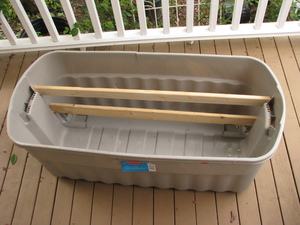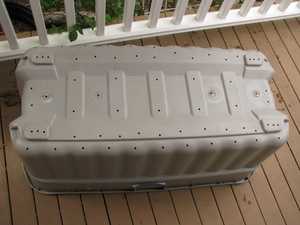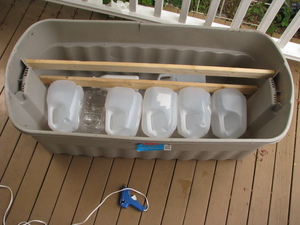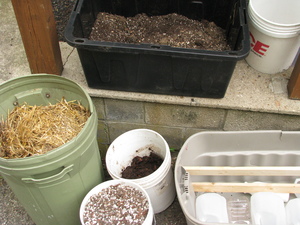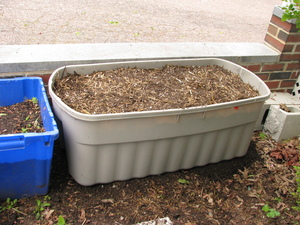Alcohol rocket
Jul. 10th, 2022 07:53 pmToday's excitement was building and testing an alcohol rocket! (This was inspired by https://www.youtube.com/watch?v=wuz0curb_hg)
Proof of concept: I dug through the recycling and found a discarded 1L plastic water bottle, added a drizzle of 70% alcohol, shook it around, emptied out the extra, and waved a lighter flame past the end -- success! A sizeable jet of flame and a whooshing sound. (The bottle was warm and the top was slightly warped and shrunken, which is to be expected.)
(Safety note: Yes, you can get burned this way. Keep your fingers at least an inch below the line extending out from the nozzle. I believe the safe way to do this is to squeeze the bottle slightly to puff some fuel/air mix out towards the flame. Much safer is to just skip this and go on to electric ignition...)
Second proof of concept: I dug around in my parts bin and found an empty piezo-igniting lighter (rather than the spark-wheel kind) and removed the igniter. I located a long 4P2C (single-line telephone) cord and cut off the ends, then temporarily wired it to the lighter's contacts. I was able to get a spark on the other end, and ignite the bottle that way. Electric ignition confirmed!
(I spent a long while trying to properly solder the wire to the igniter, then broke the igniter... and found I had another igniter that was easier to work with -- one that came from one of those long lighters made for grills or something. I just twisted the wires together this time.)
Horizontal test: I rolled up a newspaper (remember those?) into a tight cylinder with the cord at its center, sticking out a few inches at the end. Once it was about thick enough, I masking-taped it into shape. Launch tube! Launch tube hanging off of a wall with a rock weighing down one end, alcohol in the bottle, launch tube inserted into the bottle about halfway, make the spark. A few false starts until I had the mix right, and then BAM-whoosh! Bottle goes across the yard into the chain link fence.
Refinement: I thickened one part of the launch tube with more rolled paper and tape, so the bottle slides to a stop and lightly pressure-fits into the right position and with the tube centered. Just a few drops of Everclear (95% ethanol) seems to be about right. A little more and it gets more violent. I'm not too concerned about it blowing up (the bottle can slide off the tube freely, and is very light) but I'll switch to a soda bottle before experimenting with that -- bottles intended to hold carbonated liquids are built for higher pressures.
Still to do:
- Make a stand so it can actually launch upright
- Find a park where I can do a proper launch
- Maybe look around for a stronger ignition source so I can use a longer wire, which would make me feel more comfortable having the kid launch it. (The current igniter seemed to have too much voltage drop over a longer wire, but it's also possible I was still having fuel mix issues at the time.)
Proof of concept: I dug through the recycling and found a discarded 1L plastic water bottle, added a drizzle of 70% alcohol, shook it around, emptied out the extra, and waved a lighter flame past the end -- success! A sizeable jet of flame and a whooshing sound. (The bottle was warm and the top was slightly warped and shrunken, which is to be expected.)
(Safety note: Yes, you can get burned this way. Keep your fingers at least an inch below the line extending out from the nozzle. I believe the safe way to do this is to squeeze the bottle slightly to puff some fuel/air mix out towards the flame. Much safer is to just skip this and go on to electric ignition...)
Second proof of concept: I dug around in my parts bin and found an empty piezo-igniting lighter (rather than the spark-wheel kind) and removed the igniter. I located a long 4P2C (single-line telephone) cord and cut off the ends, then temporarily wired it to the lighter's contacts. I was able to get a spark on the other end, and ignite the bottle that way. Electric ignition confirmed!
(I spent a long while trying to properly solder the wire to the igniter, then broke the igniter... and found I had another igniter that was easier to work with -- one that came from one of those long lighters made for grills or something. I just twisted the wires together this time.)
Horizontal test: I rolled up a newspaper (remember those?) into a tight cylinder with the cord at its center, sticking out a few inches at the end. Once it was about thick enough, I masking-taped it into shape. Launch tube! Launch tube hanging off of a wall with a rock weighing down one end, alcohol in the bottle, launch tube inserted into the bottle about halfway, make the spark. A few false starts until I had the mix right, and then BAM-whoosh! Bottle goes across the yard into the chain link fence.
Refinement: I thickened one part of the launch tube with more rolled paper and tape, so the bottle slides to a stop and lightly pressure-fits into the right position and with the tube centered. Just a few drops of Everclear (95% ethanol) seems to be about right. A little more and it gets more violent. I'm not too concerned about it blowing up (the bottle can slide off the tube freely, and is very light) but I'll switch to a soda bottle before experimenting with that -- bottles intended to hold carbonated liquids are built for higher pressures.
Still to do:
- Make a stand so it can actually launch upright
- Find a park where I can do a proper launch
- Maybe look around for a stronger ignition source so I can use a longer wire, which would make me feel more comfortable having the kid launch it. (The current igniter seemed to have too much voltage drop over a longer wire, but it's also possible I was still having fuel mix issues at the time.)
